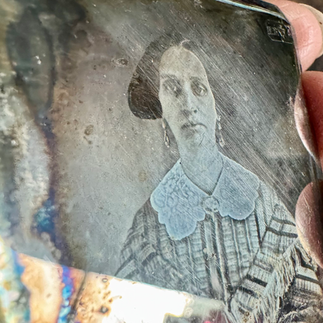Exploring the Timeless Art of Daguerreotypes: Early Photography and My Work in Progress - Part 1
- J. Morgyn White

- Mar 10, 2024
- 2 min read

When I began the research for my current work in progress, I was thrilled to discover that the timing was going to work for a number of interests of mine - one of which is early photography.
It was years ago when I first wandered into a spiral of learning about daguerreotypes when I was made keeper of the family photographs of which I found to my delight many were tintypes.

I wanted to date them of course, and learned that Tintypes, also called Ferrotypes, were produced in vast quantities in the 1860s and 1870s. Tintypes were made quickly and were affordable. In the 1880s they even had early photo booths which made ‘gem’ sized tintypes. The albums are adorable, I encourage you to look them up!

From there we get the Albumen photographs on cardboard called Cabinet cards (or depending on size :the smaller earlier ones are Cartes de Visites/CDVs), then on paper. But it was the glass ones that intrigued me first - the ambrotypes of the 1850s which were also relatively inexpensive. Ambrotypes are basically a glass negative set on a black background so they can be viewed. They are often mistaken for Daguerreotypes and may actually be a little rarer, even though they aren’t as widely collected. Some Ambrotypes have gorgeous definition.

But when I discovered the crispness of the daguerreotypes of the 1840s, I was smitten. The Daguerreotype, a process of capturing an image in silver on copper using iodine and mercury vapor was discovered in 1839—which coincides with my book’s starting date. Some of the earlier examples also have a 'hallmarked' plate which allows them to be dated. I have one in 'pieces' below. You'll see the impressed mark on the plate in the upper right. I still have a lot to learn but I'm really enjoying the exploration of early photographic processes.
Entrenched in my book research I began to expand my tiny collection with a few faces which might be considered for character profiles. The heroine of my book is a teenager to begin with so it's been fun looking at younger people to find faces that jumped out.
To me, why Daguerreotypes are so exciting (besides the gorgeous clear images which can be found) is because they were a shift in how people could remember images. Before the photograph, images of your family might be painted. If you were wealthy you might sit for a portrait or have a miniature made of your face to be sent to a loved one (or potential spouse). Photographs changed how people were recalled by family and friends—but also by history and culture. Imagine a world today without photographs. What would you use for identification?

Next time I'll share some insights on dating photos and interesting cases :) Looking for a quick ID guide for photographs?
Or How to Date Photographs?
*All photos shown are part of my small private collection.






Comments